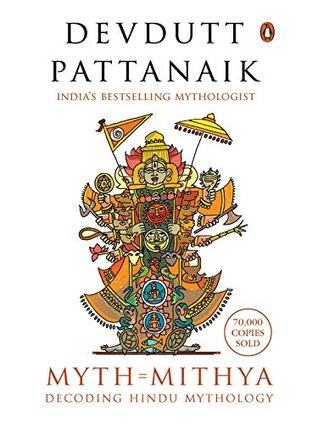More on this book
Community
Kindle Notes & Highlights
Read between
February 15 - March 13, 2020
A village goddess or Grama-devi is characterized by her eyes, indicating she is sensitive to the needs of her worshippers. With an upward-pointing palm, the goddess offers emotional comfort. With a downward-pointing palm, the goddess offers material gifts. Her nose ring and bangles are a reminder that the goddess is domesticated:
Jupiter enters the house of Aries, and the sun enters the house of Capricorn. This planetary alignment takes place once in twelve years, which is marked by the Maha Kumbha Mela, the great gathering of holy men, believed to be the largest religious congregation in the world.
Serpents are symbols of change and renewal. Like the earth they renew their fertility by replacing old skin with new. Since they could slither above and below the earth, they were considered keepers of the earth’s secrets and hence symbols of occult lore.
Kubera is neither Deva nor Asura nor Naga nor Rishi. He is a Yaksha. This class of beings is associated with water, metals and gems.
They are hoarders of wealth. Kubera, king of the Yakshas, lives in the city of Alakapuri in the north. He is the treasurer of the Devas.
Vishnu is svayambhu for Vaishnavas and Shiva svayambhu for Shaivas. For Shiva worshippers, a human dies when Indra blinks, Indra dies when Brahma blinks, Brahma dies when Vishnu blinks and Vishnu dies when Shiva blinks. Vishnu worshippers disagree with this. They believe Brahma dies when Shiva blinks and Shiva dies when Vishnu blinks.
The Veda is believed to be of non-human origin, a container of timeless wisdom. Brahma sang these hymns out when he first saw Saraswati. These were transmitted to humans through seers known as Rishis. The seers who sat around Brahma heard four collections of Vedic mantras emerging from his four heads. These collections or samhitas came to be known as Rig, Sama, Yajur and Atharva. Of these Rig Samhita is believed to be the purest transmission.
Every creature experiences the world differently. Every jiva is unique. But in essence everyone is the same: a Brahma sitting on the lotus that rises from the navel of Vishnu, looking for answers in three worlds. Hence the Vedic maxim ‘Aham Brahmasmi’.
Yama, who determines the journey the soul will take, is therefore not merely god of death but also god of destiny.
the jiva craves for peace with the three worlds his three bodies engage with. Hence all Hindu rituals end with a triple appeal, ‘Shanti, shanti, shanti’. Let me be at peace with myself, my world and the rest there is.
Asuras are strong when the moon is waning. Asuras are stronger at night. Together with the Devas, the Asuras complete the year, the month and the day.
Lakshmi is sometimes described as Pulomi, the sister of the Asuras, and sometimes as Bhargavi, the daughter of their priest, Shukra.
Bhisma, who could not be killed so long as he held a bow in his hand. He would never raise a bow against a woman but women were not allowed into the battlefield. Knowing this, Krishna made Shikhandi ride on Arjuna’s chariot.
Hindus are advised against reading the Mahabharata inside their homes for fear that ideas in that book, such as brothers fighting over property, will pollute family values. They prefer reading the Ramayana because in it brothers never fight over inheritance.
The Bhagavata is full of innocence, adventure and romance. The Mahabharata is full of intrigue, politics and philosophy.
At the appointed hour, it was time for Rama to die. But Yama, the god of death, could not enter Rama’s city, as Hanuman, the mighty monkey, guarded its gates.
To distract Hanuman and to let nature take its course, Rama dropped his ring into a crack on the floor and asked Hanuman to fetch the ring. The crack led Hanuman to a subterranean realm, where he found countless copies of Rama’s ring. The guardian of the subterranean realm, the serpent-king Vasuki, explained,‘Whenever a ring falls here, a monkey follows it and we know it is time for a Rama to die.
In each world there will be a Hanuman, a Rama and a Rama’s ring.’ (Ramayana)
Ash is the symbol of the soul. Like the soul it is indestructible.
The horizontal orientation of Shiva’s sacred lines represents inertia. Shiva is the complete opposite of Vishnu, whose sacred mark is oriented vertically, indicating activity.
There are different types of yoga for different types of people: bhakti yoga for those who are more emotional, gyan yoga for those who are more intellectual, karma yoga for those who are more social, hatha yoga for the athletic, mantra and tantra yoga for those more ritualistic.
Whatever the type of yoga chosen, the ultimate destination is sat–chitta–ananda.
Shiva’s path is the path of the hermit, nivritti marga. Vishnu’s path is the path of the householder, pravritti marga.
Vishnu constantly strives to balance yoga and bhoga. He has therefore beside him Saraswati, embodiment of yoga, dressed in white, and Lakshmi, embodiment of bhoga, dressed in red.


